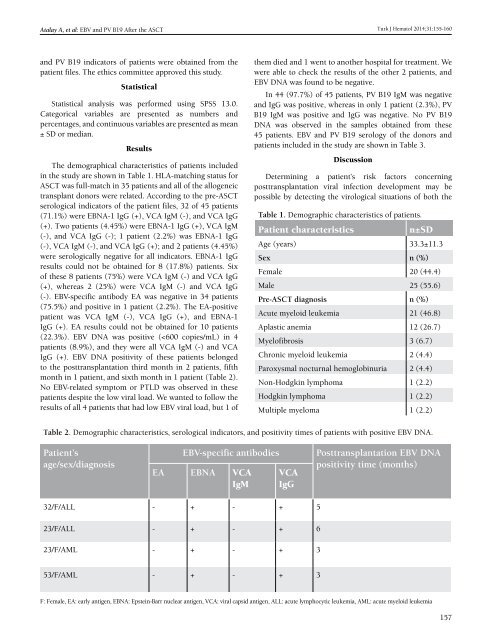Turkish Journal of Hematology Volume: 31 - Issue: 2
Create successful ePaper yourself
Turn your PDF publications into a flip-book with our unique Google optimized e-Paper software.
Atalay A, et al: EBV and PV B19 After the ASCT<br />
Turk J Hematol 2014;<strong>31</strong>:155-160<br />
and PV B19 indicators <strong>of</strong> patients were obtained from the<br />
patient files. The ethics committee approved this study.<br />
Statistical<br />
Statistical analysis was performed using SPSS 13.0.<br />
Categorical variables are presented as numbers and<br />
percentages, and continuous variables are presented as mean<br />
± SD or median.<br />
Results<br />
The demographical characteristics <strong>of</strong> patients included<br />
in the study are shown in Table 1. HLA-matching status for<br />
ASCT was full-match in 35 patients and all <strong>of</strong> the allogeneic<br />
transplant donors were related. According to the pre-ASCT<br />
serological indicators <strong>of</strong> the patient files, 32 <strong>of</strong> 45 patients<br />
(71.1%) were EBNA-1 IgG (+), VCA IgM (-), and VCA IgG<br />
(+). Two patients (4.45%) were EBNA-1 IgG (+), VCA IgM<br />
(-), and VCA IgG (-); 1 patient (2.2%) was EBNA-1 IgG<br />
(-), VCA IgM (-), and VCA IgG (+); and 2 patients (4.45%)<br />
were serologically negative for all indicators. EBNA-1 IgG<br />
results could not be obtained for 8 (17.8%) patients. Six<br />
<strong>of</strong> these 8 patients (75%) were VCA IgM (-) and VCA IgG<br />
(+), whereas 2 (25%) were VCA IgM (-) and VCA IgG<br />
(-). EBV-specific antibody EA was negative in 34 patients<br />
(75.5%) and positive in 1 patient (2.2%). The EA-positive<br />
patient was VCA IgM (-), VCA IgG (+), and EBNA-1<br />
IgG (+). EA results could not be obtained for 10 patients<br />
(22.3%). EBV DNA was positive (

















